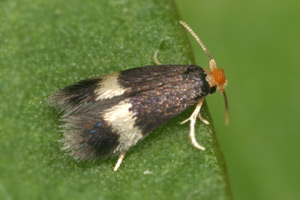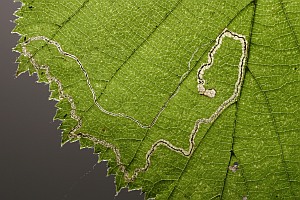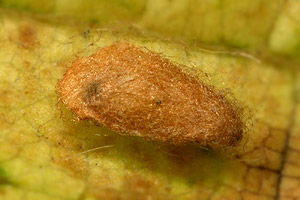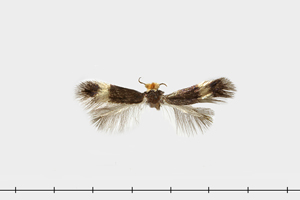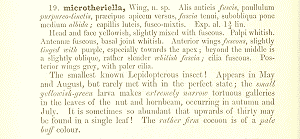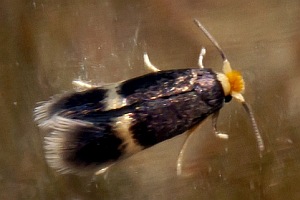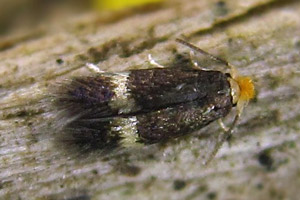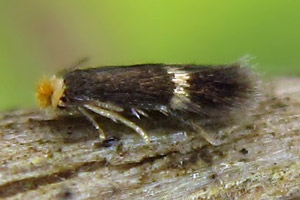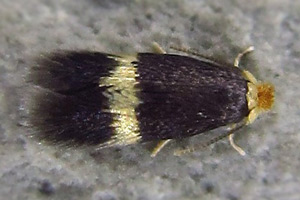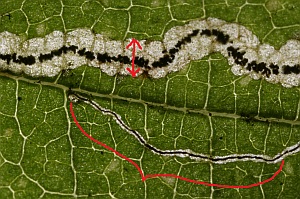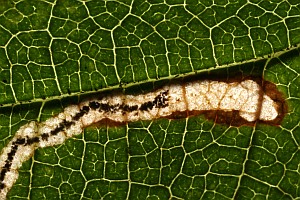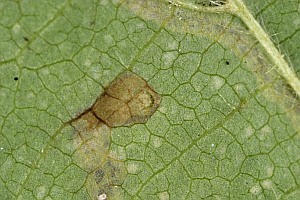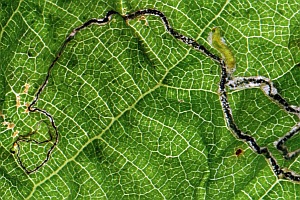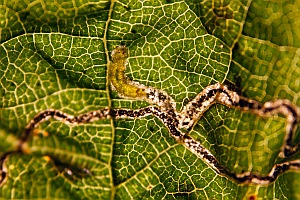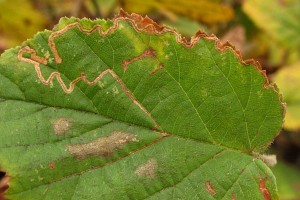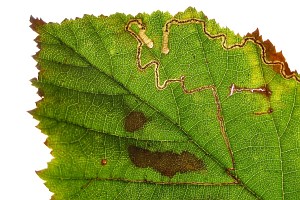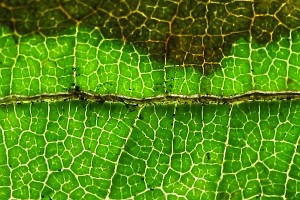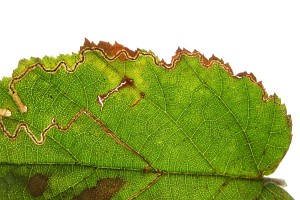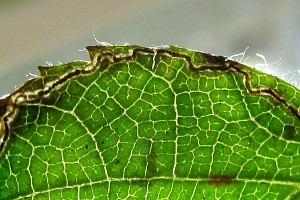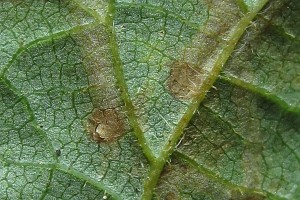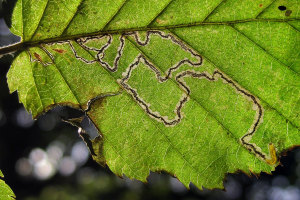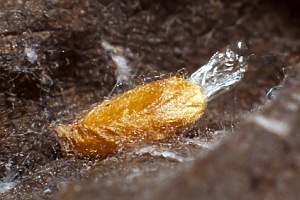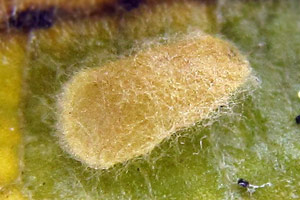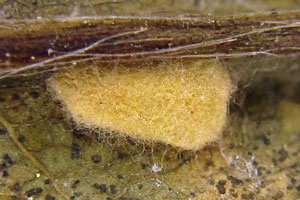

 +39Kontinente:EUASNAOC
+39Kontinente:EUASNAOC1. Lebendfotos
1.1. Falter
1.2. Fraßspuren und Befallsbild
1.3. Kokon
2. Diagnose
2.1. Weibchen
2.2. Mine
Die Bestimmung der Nepticuliden-Minen in Haselnuss-Blättern ist relativ einfach, denn es kommen nur 2 Arten vor: Stigmella floslactella und Stigmella microtheriella.
Bei Stigmella floslactella ist die Kotlinie am Anfang der Mine breit und lässt nur schmale helle Ränder frei, erst später werden die hellen Ränder breiter. Bei Stigmella microtheriella ist die Kotlinie am Anfang schmal, weniger als die halbe Breite der Mine.
Bei Stigmella floslactella miniert die Raupe (nach Hering 1957) mit der Dorsalseite Richtung Blattoberseite. Das ist zwar direkt an der Raupe kaum feststellbar, wohl aber an der Lage des Schlitzes, durch den die Raupe die Mine verlassen hat: dieser liegt an der Dorsalseite, hier also an der Blattoberseite. Bei Stigmella microtheriella miniert die Raupe (nach Hering 1957) mit der Dorsalseite Richtung Blattunterseite. Der Schlitz, durch den die Raupe die Mine verlassen hat, liegt hier also an der Blattunterseite. (Wurde bisher an 3 Stigmella floslactella- und 10 Stigmella microtheriella-Minen überprüft und bis dahin als korrekt bestätigt. Weitere Untersuchungen zur Konstanz dieses Merkmals sind erwünscht)
Beide Arten unterscheiden sich auch in der Breite der Mine: Bei Stigmella floslactella erreicht die Mine kurz vor dem Verlassen der Raupe 1,1 - 1,4 mm Breite, bei Stigmella microtheriella nur 0,7 - 0,9 mm (Messwerte nach eigenen Beobachtungen).
An Hainbuche (Carpinus betulus), wo diese Arten auch vorkommen, ist die Bestimmung kritischer.
(Text: Peter Buchner nach Hering 1957 und Laštůvka 1997)
2.3. Erstbeschreibung
3. Biologie
3.1. Nahrung der Raupe
- [Betulaceae:] Carpinus betulus (Gemeine Hainbuche)
- [Betulaceae:] Carpinus orientalis (Orientalische Hainbuche)
- [Betulaceae:] Carpinus tschonoskii (Tschonoskis Hainbuche) [Japan, Südkorea]
- [Betulaceae:] Corylus avellana (Haselnuss)
- [Betulaceae:] Corylus colurna (Baum-Hasel)
- [Betulaceae:] Corylus maxima (Lambertsnuss)
- [Betulaceae:] Ostrya carpinifolia (Gemeine Hopfenbuche)
- [Betulaceae:] Ostrya virginiana (Virginische Hopfenbuche)
- [Betulaceae:] Betula platyphylla (Japanische Weiß-Birke) [bisher nur Japan]
[Bladmineerders.nl] nennt neben Haseln und Hainbuchen auch Hopfenbuchen als Nahrungspflanzen, also ausschließlich Betulaceae. In Europa werden die einheimischen Arten Carpinus betulus, Corylus avellana und Ostrya carpinifolia genutzt, in Parks dann auch weitere Arten dieser Gattungen. Nach Nieukerken et al. (2016) sind die Minen in Korea und Japan an Carpinus, Corylus, Ostrya zu finden, in Japan auch an Betula. Nachweise an Birken fehlen aus Europa hingegen ganz.
4. Weitere Informationen
4.1. Etymologie (Namenserklärung)
Stainton (1854): "The smallest known Lepidopterous insect!" Altgriechisch μικρός = klein und τὸ θηρίον = das Tier.
4.2. Andere Kombinationen
- Nepticula microtheriella Stainton, 1854 [Originalkombination]
4.3. Synonyme
- Stigmella cathepostis Kemperman & Wilkinson, 1985 [synonymisiert durch Nieukerken et al. (2016)]
4.4. Taxonomie und Faunistik
Nieukerken et al. (2016) gehen in einem langen Kommentar auf die Art ein: "16 Stigmella microtheriella (Stainton, 1854) was recorded from China (van Nieukerken and Liu 2000) and Japan (Hirano 2013). During our recent fieldwork in Korea and Japan we found larvae on Carpinus, Corylus and Betula (Hokkaido: RMNH.INS.29748; new host record, Fig. 56) (in Japan also found on Ostrya, N. Hirano pers. comm.) of which the DNA barcode shows a very short distance (1.11%) to European S. microtheriella, still clustering together (BIN Korea/Japan: BOLD:ACU7085, Europe: BOLD:AAI0007) (see Fig. 57). We reared both males and females from these Asian specimens, whereas in most of Europe S. microtheriella is parthenogenetic (but we reared males from Greece and Laštůvka and Laštůvka 1997 recorded males from Croatia). Originally we considered the presence of S. microtheriella in East Asia as an introduction, but the separate, but similar barcode, suggests the species is an indigenous element of the East Asian fauna. By comparing male genitalia to the type of S. cathepostis Kemperman & Wilkinson, 1985 (Figs 48–50), we realised that the latter is nothing else than male S. microtheriella and hence synonymise it here, even though the uncus of east Palearctic specimens seems to have a deeper indentation than European males (compare Figs 48–53 with 54 and 55). S. cathepostis was also recorded from Russia: Primorye (Rocienė and Stonis 2013), and we here also illustrate a male from Primorye (Fig. 53). It is unclear whether Stigmella microtheriella is a trans Palearctic species, since its best known hosts, Corylus, Carpinus and Ostrya do not have a continuous distribution, but show a gap between the Urals and the middle of China (Sokolov et al. 1980; Fang et al. 2011). A continuous distribution, however, might still be a possibility, since apparently Betula, that occurs throughout Siberia, can be an alternative host (see above and Fig. 56). Recently, S. microtheriella was also recorded from North America (Eiseman and van Nieukerken 2015), but DNA barcodes show that here indeed it is an introduced species, as it is in New Zealand (Donner and Wilkinson 1989)."
Nach der Karte der [mothphotographersgroup.msstate.edu (abgefragt 15. Juli 2023)] ist die Art in den USA bisher auf die Westküste beschränkt.
Donner & Wilkinson (1989: 5) schrieben im Vorspann zu den 28 Nepticuliden-Arten Neuseelands: "All are placed in genus Stigmella Schrank, and all except microtheriella Stainton are considered to be endemic." Und S. 28 kommen die Details und auch die Erklärung dafür, warum ausgerechnet diese Art für Verschleppungen prädestiniert ist: "The species owes its presence in New Zealand to two unusual though not unique characters amongst the Nepticulidae. Firstly the cocoon is spun on the stem of the foodplant, and can thus be transported on dormant twigs when the larva/cocoon remain inactive. Secondly the progeny are alway parthenogenetic females, thus there need be only one introduction. The localities for this species are Smith's Ford, Maitai Valley, Nelson and "Broadgreen" Stoke, Nelson. Smith's Ford is a small alluvial flat in the Maitai Valley farmed in the 1850s and 1860s by a Mr Smith, who brought out cuttings of hazel from Britain. Most probably microtheriella cocoons were already on the cuttings right from the start. It is likely that the Broadgreen hazel was infested in a similar fashion, i.e., it came with microtheriella cocoons already on it. These are the only localities where microtheriella has been found. The 1970 plantings of hazel elsewhere in Nelson, and old hazels around Rotorua, are all clear of leaf mines."
In der Summe heißt das zur Verbreitung: Die Art ist in Europa verbreitet, ebenso im östlichen Asien - ob sie dazwischen vorkommt, wissen wir noch nicht. Die Nachweise aus Nordamerika und Neuseeland beruhen sicher auf Einschleppungen. Zumindest in Neuseeland scheint es nicht zu einer weiteren Etablierung gekommen zu sein.
(Autor: Erwin Rennwald)
4.5. Literatur
- Donner, H. & C. Wilkinson (1989): Nepticulidae (Insecta: Lepidoptera). — Fauna of New Zealand Number 16 Nepticulidae (Insecta: Lepidoptera). 92 S.; Wellington (DSIR Publishing). [PDF auf landcareresearch.co.nz]
- Nieukerken, E.J. van, Doorenweerd, C., Hoare, R.J.B. & D.R. Davis (2016): Revised classification and catalogue of global Nepticulidae and Opostegidae (Lepidoptera, Nepticuloidea). — ZooKeys 628: 65–246. doi: 10.3897/zookeys.628.9799. [Open-access-Dokument auf pensoft.net und Zugang zum PDF]
- SCHÜTZE (1931): 58
- Lectotypus-Festlegung: Schoorl, J. W. & C. Wilkonson (1986): The Stigmella betulicola species-group in Europe (Lepidoptera: Nepticulidae). — Journal of Natural History 20 (1): 225-244.
- Erstbeschreibung: Stainton, H. T. (1854): Insecta Britannica. Lepidoptera: Tineina. i-viii + 1-313 + 10 pl. London (Lovell Reeve).
- Stainton, H. T. (1855): The Natural History of the Tineina. Volume I. Containing Nepticula. Part I. Cemiostoma. Part I: I-XV, 1-338, Nepticula pl. I-VII, Cemiostoma pl. I. London (John van Voorst), Paris (Deyrolle), Berlin (E. S. Mittler und Sohn). — Digitalisat auf archive.org: [118], [pl. II (fig. 3)].






































